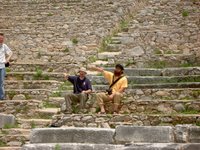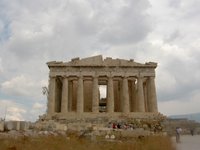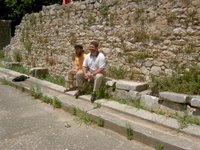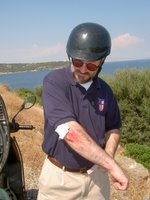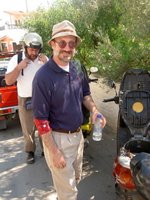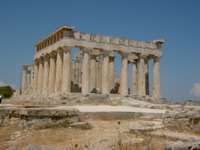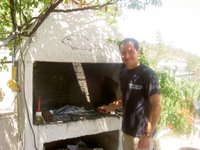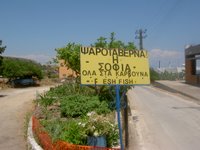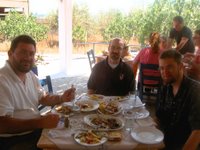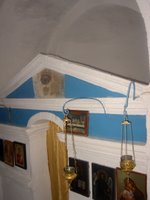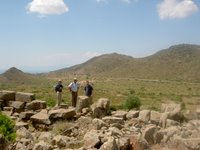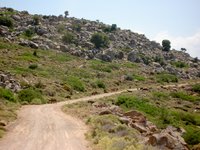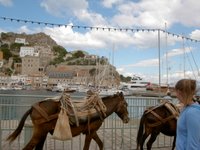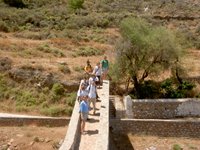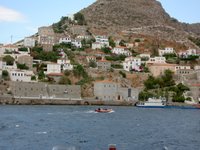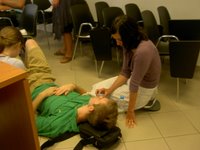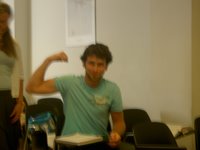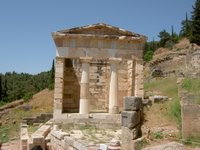
Day one of four-day trip.
After a few hours of driving we reached Delphi. It's easily one of the highlights of the entire trip. Before the hordes of tourists it must have been absolutely breathtaking. Even now it is a mystical place. The site is tucked into a hill, with each major building progressively higher than the previous one, so you walk up past the treasuries, past the Temple of Apollo, past the theatre, and finally, a long trek up to the stadium. Fortunately, we were well briefed on location by our marvelous guide, Rania, whose depth of knowledge was truly amazing even to thoseof us who knew something about the site already.
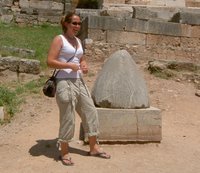
Delphi was considered to be the omphalos ("belly-button") of the Greek world. The story goes that Zeus released two eagles in opposite direction, and the place where they met was Delphi. and Here Joy compares her belly button to the large omphalos on the Sacred Way. The original, much more ornate, is in the museum.
Various city-states (poleis) would dedicate thank-offerings to Delphi. Over time so much stuff was accumulated that they built treasuries--little storehouses for all the loot kept there. The Archaic (early 5th cent.) Treasury of the Athenians was built after the Battle of Marathon and is the only treasury to be totally reconstructed. The metopes of the Doric treasury illustrate the labors of Heracles.
On nine days every year, one could consult with the Pythia (priestess of Apollo) who gave her riddling prophecies in a trance perhaps induced by gas emanating from a chasm under her
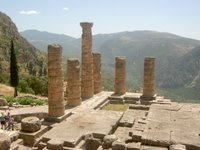
tripod placed in the back of the Temple of Apollo. The temple has 6 Doric columns in front and 13 on the side. Here you can see the front of the Temple with four of the columns mostly still there.
On the front of the temple was inscribed the phrases, "Know Thyself," "Nothing to Excess" and "
The 4th-century theatre was the home to musical competitions, seating 5,000. I tested it out with some lines from Hamlet ("Tomorrow, and tomorrow, and tomorrow, creeps in this petty pace...), and those standing at the very top of the theatre heard with no problem. (I also got applause from the people standing around me.)
We hiked up to the stadium (2nd century AD), which was not as crowded as the rest of the site. Here you can see the "deluxe" stone seats which would have faced the finish line.

The museum is airy and well lit, with excellent sculptures including the famous Sphinx of Naxos and the statues of Cleobis and Biton (well, maybe). The real showpiece is the Charioteer of Delphi. They told us that you can "take pictures of the exhibits, but not the people." I didn't know why we would want to take pictures of the museum staff, but later on realized that they meant they didn't want tourists standing in front of the pieces for photo ops!
After the museum we traveled the short distance to Delphi town for lunch. The town itself is
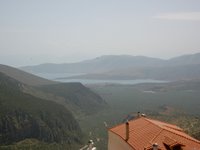
quiet, just two main roads parallel to one another. We ate lunch at Taverna Vrakgos. I had eggplant salad and calamari, Marshall had lamb in lemon sauce with rice and potatoes. We split a half-carafe of local red wine. Delicious! And what about the view from the terrace?
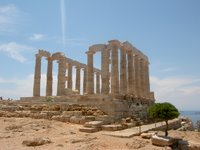
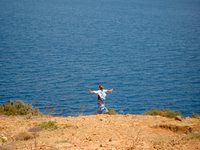
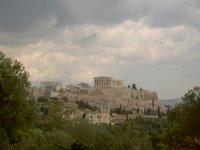
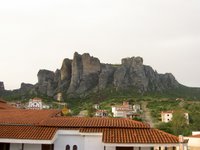 Meteora
Meteora